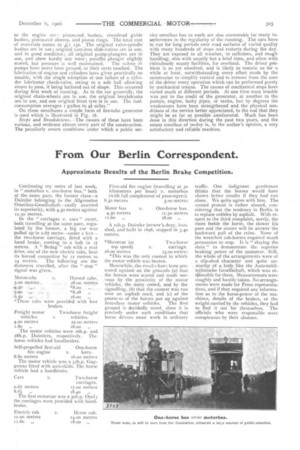From Our Berlin Correspondent
Page 27

If you've noticed an error in this article please click here to report it so we can fix it.
Approximate Results of the Berlin Brake Competition..
Continuing my notes of last week, in " motorbus v. one-horse bus," both at the same pace, the former class-a Daimler belonging to the Allgemeine Omnibus-Gesellschaft-easily asserted its superiority, with 4.5o metres against 12.31) metres.
In the " carriages v. cars" event, both travelling at the same pace, regulated by the former, a big car was pulled up in 0.67 metre-under 2 feetthe two-horse carriage, fitted with a hand brake, coming to a halt in 17 metres. A " Bedag " cab with a rear drive, one of the new electric cabs, beat its horsed competitor by 12 metres to
24 metres. The following are the distances travelled, after the " stop " signal was given.
otorc a bs v. Horsed cabs.
5.00 metres28.00 metres
446510 *8.00 „ .3.90
6.so i 16.00 „ *These cabs were provided with foot brakes.
Freight motor Two-horse freight vehicles v vehicles.
4.00 metres 22.00 metres
1.80 ,, 18.00 „ The motor vehicles were 16h.p. and 28h.p. Daimlers, respectively. The horse vehicles had handbrakes.
Self-propelled first-aid One-horse fire engine v. lorry. 8.8o metres 16.00 metres The motor vehicle was a 32h.p. Gaggenau fitted with anti-skids. The horse vehicle had a handbrake.
Cars v. Two-horse carriages. 0.67 metres 17.00 metres 8.65 „ 18.40 „ The first motorcar was a soh.p. Opel ; the carriages were provided with handbrake.
Electric cab v. Horse cab.
12m0 metres 24.00 metres 11.6o „ 18.00 „ First-aid lire engine (travelling at Jo kilometres per hour) v. motorbus (with full complement of passengers). 8.50 metres 5.00 metres Motor bus v. One-horse bus.
4.50 metres 12.30 metres it.6o 18.00 „ A toh.p. Daimler brewer's dray, ironshod, and built in 1898, stopped in 3.40 metres.
*Motorcar (at Two-horse
top speed) 7Y. carriage.
26.00 metres 23.00 metres *This was the only contest in which the motor vehicle was beaten. Meanwhile, the results have been protested against on the grounds (a) that the horses were scared and made nervous by the proximity of the motor vehicles, the noisy crowd, and by the (b) that the contest was run over an asphalt road, and (c) of the poorness of the horses put up against
first-class motor vehicles. The first ground is decidedly novel, since it is precisely under such conditions that horse drivers must work in ordinary traffic. One indignant gentleman thinks that the horses would have shown better results if they had run alone. We quite agree with him. The second protest is rather absurd, considering that the tendency in Berlin is to replace cobbles by asphalt. With respect to the third complaint, surely, the more feeble the horse, the slower his pace and the sooner will he answer the backward pull of the reins. None of the wretched cab-horses required much persuasion to stop. It is " slaying the slain " to demonstrate the superior braking power of the motorcar. Still, the whole of the arrangements were of a slip-shod character and quite unworthy of a body, like the Autornobiltechnische Gesellschaft, which was resTionsibIe for them, Measurements were roughly and hastily taken. No arrangements were made for Press representatives, and if they required any information as to the horse-power of the machines, details of the brakes, or the weight carried by the vehicles, they had to find it out for themselves. The officials who were responsible were conspicuous by their absence.




























